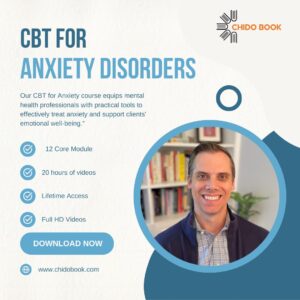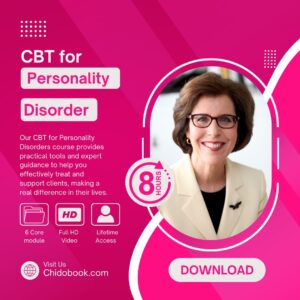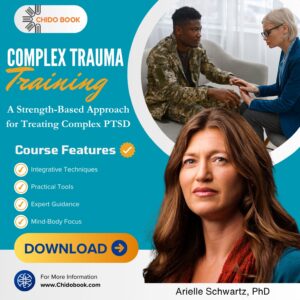.
CBT for Anxiety Disorders
Equip Yourself with Proven Tools to Address Anxiety Disorders like GAD, Panic, Social Anxiety, and OCD

The CBT for Anxiety On-Demand Training Course is designed to equip mental health professionals with the tools and techniques needed to effectively treat anxiety disorders. Developed in collaboration with the Beck Institute, this comprehensive course provides a practical, evidence-based approach to managing conditions such as Generalized Anxiety Disorder (GAD), Panic Disorder, Social Anxiety Disorder, and Obsessive-Compulsive Disorder (OCD).
Through a series of engaging lectures, case studies, and role-plays, participants will learn how to apply cognitive behavioral interventions in real-world scenarios, helping their clients overcome anxious thoughts, avoidant behaviors, and emotional regulation challenges.
Learning Objectives:
- How to develop cognitive conceptualizations for anxiety disorders.
- Effective techniques for identifying and challenging anxious thoughts.
- Designing and implementing behavioral experiments and exposure exercises.
- Integrating mindfulness and relaxation techniques into therapy.
- Tailoring CBT interventions for specific anxiety disorders, including GAD, panic disorder, social anxiety, and OCD.
This course provides practical, real-world skills that you can begin using with clients right away. Whether you’re a psychologist, counselor, social worker, or mental health nurse, you’ll gain confidence and competence in treating anxiety disorders through cognitive-behavioral therapy.
By the end of the course, you’ll have a deeper understanding of how to deliver results-driven therapy that helps your clients manage and overcome anxiety.
Let’s take a look at the topics
The subjects covered in the “CBT for Suicide Prevention” course include a range of topics designed to provide a thorough understanding of suicide prevention through the lens of Cognitive Behavioral Therapy (CBT). Here’s a detailed breakdown of the subjects:
- Module 1: The Basics (Part 1)
- Research on CBT For Anxiety Disorders
- Sarah's First Therapy Session
- The Cognitive Model
- The Risk/Resource Model
- Focus of Attention
- Anxiety about Anxiety
- Avoidance & Safety Behaviors
- Module 2: The Basics (Part 2)
- The Evaluation Session
- Identifying Values and Aspirations and Setting Goals
- An Overview of Cognitive Case Conceptualization
- The Cognitive Model
- Cognitive Models for Sarah
- Relevant Life History
- Core Beliefs
- Coping Strategies and Intermediate Beliefs
- Cognitive Case Conceptualization
- Strength-Based Cognitive Conceptualization Diagram (SB-CCD)
- Therapeutic Relationship
- Session Structure
- Treatment Structure
- Module 3: Cognitive Interventions (Part 1)
- Presenting the Cognitive Model to Clients
- Identifying Automatic Thoughts
- Evaluating Automatic Thoughts, Gathering Evidence, and Coping Cards
- Module 4: Cognitive Interventions (Part 2)
- De-Catastrophizing, Problem Solving, and Alternative Explanations
- Worksheets to Evaluate and Respond to Automatic Thoughts
- in Using Cognitive Restructuring
- Cost-benefit Analyses
- Module 5: Behavioral Interventions: Behavioral Experiments
- Creating and Reviewing Behavioral Experiments
- In-session Behavioral Experiments
- Module 6: Behavioral Interventions: Exposures (Part 1)
- Exposure Exercises and the Cognitive Formulation of Anxiety
- The Rationale for Exposure Exercises
- Exposure Hierarchies
- an Exposure and Safety Behaviors
- the Clients’ Focus of Attention, Rating Anxiety Levels, and Cognitive Restructuring
- Reviewing Experiences and Drawing Conclusions
- Module 4: Cognitive Interventions (Part 2)
- De-Catastrophizing, Problem Solving, and Alternative Explanations
- Worksheets to Evaluate and Respond to Automatic Thoughts
- in Using Cognitive Restructuring
- Cost-benefit Analyses
- Module 5: Behavioral Interventions: Behavioral Experiments
- Creating and Reviewing Behavioral Experiments
- In-session Behavioral Experiments
- Module 6: Behavioral Interventions: Exposures (Part 1)
- Exposure Exercises and the Cognitive Formulation of Anxiety
- The Rationale for Exposure Exercises
- Exposure Hierarchies
- an Exposure and Safety Behaviors
- the Clients’ Focus of Attention, Rating Anxiety Levels, and Cognitive Restructuring
- Reviewing Experiences and Drawing Conclusions
- Module 10: Panic Disorder
- Diagnostic Criteria for Panic Disorder
- Cognitive Model of Panic Disorder
- Cognitive Model of Panic Disorder Example: Mike
- Hypervigilance, Safety Behaviors, and Avoidance
- Cognitive Conceptualization: Mike
- Tailoring CBT to Panic Disorder
- Cognitive Restructuring of the Catastrophic Misinterpretation
- Interoceptive Exposures
- Therapy Session: Interoceptive Exposure
- Breathing Retraining
- In-Vivo Exposures
- A Recovery-Oriented Approach to In-Vivo Exposures
- Strategies When Clients Refuse or Avoid Exposures
- Symptom Acceptance
- The Use of Medication
- Module 11: Social Anxiety Disorder
- Diagnostic Criteria for Social Anxiety Disorder
- The Cognitive Model of Social Anxiety Disorder
- Self-Focused Attention and Constructing an Impression of Oneself as a Social Object
- Safety Behaviors
- Anxiety-Induced Skill Deficits
- Post-Event Processing
- Social Anxiety Summary and Case Example
- Tailoring CBT to Social Anxiety Disorder
- Emotional Acceptance
- Cognitive Restructuring of Anticipatory Anxiety
- A Recovery- Oriented Approach to Cognitive Restructuring
- Focus of Attention Training: Mindfulness for Attentional Control
- Focus of Attention Roleplay
- Roleplay Exposures with Video or Audio Feedback
- Post-Event Processing Reduction
- In-Vivo Exposures and Social Mishap Exposures
- Module 12: Obsessive-Compulsive Disorder
- Diagnostic Criteria for Obsessive-Compulsive Disorder
- Overview of Cognitive Model of OCD and Unwanted Mental Intrusions
- Appraisals of Obsessions
- Neutralizing Compulsions
- Appraisals of Control
- Cognitive Conceptualization: Paul
- The Longitudinal Formulation of Paul
- Tailoring CBT to Obsessive-Compulsive Disorder and Psychoeducation
- Cognitive Restructuring of Appraisals of Obsessions
- Behavioral Experiments
- In-vivo Exposure and Response Prevention
- Exposure Hierarchies
- Imaginal Exposure and Response Prevention
- Mindfulness of Intrusions
- Relapse Prevention
- Obstacles in Treating OCD
- A Recovery-Oriented Approach for OCD
These subjects ensure that participants gain a comprehensive understanding of how to effectively use Socratic questioning within CBT, covering both theoretical knowledge and practical application. Each subject is designed to build upon the previous one, creating a structured learning experience that equips participants with the skills needed to enhance their therapeutic practice.
Who Should Enroll
This course is designed for mental health professionals who want to deepen their expertise in Cognitive Behavioral Therapy (CBT) for anxiety disorders. If you work with clients struggling with anxiety, panic, OCD, or related disorders, this course is for you. It is ideal for:
- Psychologists: Looking to refine their CBT techniques and apply evidence-based treatments for anxiety.
- Psychiatrists: Interested in integrating CBT interventions into their clinical practice to complement pharmacotherapy for anxiety disorders.
- Licensed Counselors: Wanting to learn practical tools for treating generalized anxiety disorder (GAD), panic attacks, social anxiety, and OCD.
- Social Workers: Working with individuals or families affected by anxiety and seeking structured interventions to improve well-being.
- Mental Health Nurses: Providing care to patients with anxiety and wanting to better understand CBT strategies to support their mental health treatment.
- Therapists: Specializing in anxiety disorders or looking to expand their practice to include CBT interventions.
What You’ll Learn in This Course:
This course offers a comprehensive understanding of how to apply Cognitive Behavioral Therapy (CBT) to effectively treat anxiety disorders. Whether you’re a beginner or have some experience with CBT, this course will equip you with practical, step-by-step strategies you can start using in your practice immediately. Here’s a detailed look at what you’ll learn:
1. Cognitive Conceptualization for Anxiety Disorders:
You’ll dive deep into how anxiety disorders manifest and how to develop cognitive conceptualizations for clients. This involves understanding how cognitive distortions (like catastrophic thinking) and negative automatic thoughts drive anxiety. By mastering cognitive conceptualization, you’ll be able to:
- Create personalized treatment plans for clients with GAD, panic disorder, social anxiety disorder, and OCD.
- Identify core beliefs and intermediate thoughts contributing to anxiety.
- Structure therapy sessions effectively to address each client’s unique challenges.
2. Identifying and Challenging Anxious Thoughts:
One of the key principles of CBT is recognizing and addressing anxious thoughts that fuel anxiety disorders. In this course, you’ll learn how to:
- Help clients identify automatic thoughts that trigger their anxiety.
- Use cognitive restructuring techniques to challenge and modify those thoughts.
- Teach clients to evaluate the evidence for and against their anxious beliefs.
- Develop coping strategies and thought records that clients can use outside of therapy to manage anxiety independently.
3. Behavioral Interventions and Exposure Techniques:
Behavioral strategies are critical for reducing avoidance behaviors that reinforce anxiety. You’ll learn how to design and implement:
- Behavioral experiments: Test anxious thoughts by having clients confront feared situations in controlled, safe ways.
- Exposure therapy: Guide clients through in-vivo (real-world), imaginal, and interoceptive (body-based) exposure exercises to help them face and overcome their fears.
- Hierarchical exposure planning: Gradually expose clients to their fears in a step-by-step manner, reducing anxiety over time.
These behavioral interventions will empower clients to break the cycle of avoidance and build confidence in facing anxiety-inducing situations.
4. Mindfulness and Relaxation Techniques:
Anxiety disorders often come with physical symptoms such as muscle tension, restlessness, and panic-like sensations. You’ll learn to integrate mindfulness practices and relaxation techniques into therapy, helping clients manage the physical manifestations of anxiety. These tools include:
- Mindfulness of thoughts and sensations: Helping clients stay present and non-judgmental about their anxious feelings.
- Progressive muscle relaxation: A systematic way to reduce physical tension associated with anxiety.
- Diaphragmatic breathing: Teaching clients how to control their breath to lower anxiety levels during stressful situations.
By the end of this module, you’ll have a toolkit of relaxation strategies that clients can use daily to manage their anxiety.
5. Tailored CBT Interventions for Specific Anxiety Disorders:
This course goes beyond general anxiety treatment to provide tailored interventions for specific anxiety disorders. You’ll gain insights into:
- Generalized Anxiety Disorder (GAD): Learn how to use cognitive restructuring and worry management techniques to help clients reduce persistent, uncontrollable worry.
- Panic Disorder: Develop skills to treat clients suffering from panic attacks and hypervigilance using interoceptive exposures and cognitive interventions to reframe catastrophic thinking.
- Social Anxiety Disorder: Equip yourself with techniques to help clients reduce social avoidance and manage performance anxiety. You’ll explore role-play and exposure exercises designed specifically for social anxiety.
- Obsessive-Compulsive Disorder (OCD): Learn how to help clients break free from the cycle of intrusive thoughts and compulsive behaviors using exposure and response prevention (ERP) techniques.
Each disorder-specific module is packed with case studies, role-plays, and practical examples to guide you in delivering effective, targeted treatments.
6. Structuring Therapy Sessions and Treatment Plans:
In addition to learning interventions, you’ll also gain expertise in the structure and flow of CBT therapy sessions. This includes:
- Setting treatment goals based on client values and aspirations.
- Developing a session structure that integrates cognitive, behavioral, and mindfulness strategies.
- Adjusting therapy interventions to align with recovery-oriented approaches and client-specific needs.
With this knowledge, you’ll be able to confidently guide clients through a structured, evidence-based treatment process that promotes long-term anxiety management and well-being.
Why This Course Matters:
The CBT for Anxiety On-Demand Training Course provides a deep dive into the practical application of CBT for anxiety disorders. You’ll leave with the tools and knowledge to treat some of the most common and challenging mental health conditions, including GAD, panic disorder, social anxiety, and OCD. Through a combination of cognitive and behavioral interventions, mindfulness techniques, and structured exposure exercises, you’ll be better equipped to deliver transformative results for your clients.
This is not just theoretical learning—you will acquire immediately applicable skills to use in your next therapy session.
Course Director

Robert Hindman, PhD – Clinical Psychologist
Dr. Hindman is a licensed psychologist at an independent practice. He received his PhD in clinical psychology from the Catholic University of America, where his research focused on stress, anxiety, and mindfulness. He developed two mindfulness-focused stress reduction programs for his dissertation research. Dr. Hindman completed his clinical internship at the Coatesville VA medical center and post-doctoral fellowship at Beck Institute. He has co-authored book chapters on anxiety and mindfulness as well as Cognitive Behavior Therapy, written the Beck Institute online course on CBT for Anxiety Disorders, and has published several journal articles. Currently, Dr. Hindman provides Cognitive Behavior Therapy for clients with diverse presenting problems. In his role as a Beck Institute faculty member, he teaches CBT to a wide variety of mental health professionals and paraprofessionals. He has also presented to national and international audiences on the topic of CBT for anxiety disorders. Dr. Hindman also conducts individual and group consultation and supervision for therapists looking to learn or improve their skills in Cognitive Behavior Therapy. In addition, Dr. Hindman collaborates on research that aims to determine effective ways for organizations and therapists to adopt and be trained in CBT.
Trusted by Psychologists, Therapists, and Counselors from all over the World
2114 Participant
99% Positive rating
Our Happy Clients Say About Us
Don't Miss This Limited-Time Offer
BIG SALE
Get instant access for a special price-
12 Core Module
-
20 hours of videos
-
Full HD videos
-
Lifetime access
-
Save $405











6 reviews for Cognitive Behavioral Therapy for Anxiety Disorders